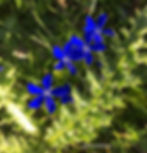Wildflowers of the Alps
- Debi Holland
- Jan 30, 2021
- 4 min read
Updated: Jan 31, 2021

In the summer of 2018 we spent a few weeks in the French Alps mountain biking, hiking and studying wildflowers. In these challenging times we find ourselves, I have enjoyed reflecting upon times gone by when travel was not forbidden and we could leisurely explore far away lands finding plants in their natural habitat.
Perched above Lake Verney (2,088m), the largest lake in the Aosta Valley at 200m wide, nestled between Bec des Rousses, the Piccolo San Bernardo promontory and the Chaz Dura mountain, this boggy land boasts water-loving plants. Although not seen on this trip the area is host to rare species of carnivorous plants, sphagnum mosses, rushes and carex.

Travelling up from the base of the Tarentaise valley through La Rosiere, passed the Col du Petit Saint-Bernard (2,188m above sea level) at the French-Italian border and down towards La Thuille in the Aosta Valley, Italy we spotted a meadow with a far reaching view stretching out towards Mont Blanc still nursing a significant patch of snow. This was too tempting to pass.

Upon closer inspection the snow was an incredible arcing wave of melting ice. The sound of dripping water, the cool temperature under the arch were all an enchanting contrast to the warm rays of the high altitude sun and blue skies surrounding us. A natural melting phenomenon.

Although the ice wave was what immediately caught our attention the real stars of the show were quietly nestled in the grasses of the meadow, wafting in the mountain breeze, basking in the bright sunlight. The plain was completely littered in exquisite wildflowers.

My anticipation was met with delight discovering Gentiana nivalis, snow gentian with its vibrant vivid blue petals shining out from the meadow floor. Everywhere you looked another star-shaped gem emerged.

One of the most fascinating Alpine plants is a common thistle known as Spiniest Thistle or Cirsium spinosissimum. It frequents the dry rocky mountain sides and damp rich soils so very apt to find it by snow melt. It is a well adapted hardy plant often found scattered over areas although I have occasionally found large groups of these thistles growing together.
It grows to about 20-80cm and flowers between July to September with many creamy coloured spiny florets contrasting against its green spiny leaves. It certainly earns its name as Spiniest Thistle.

Pulsatilla alpina, Alpine Pasqueflower is one of the craziest and most delicate beauties. From early April they can be emerging in flower when still under snow cover.
It's wild feathery seed heads slow down the surrounding cold winds to warm the air around the flower and help it survive the alpine temperatures. Standing tall in the meadow the wind is also utilised to disperse its seed.

Shining out from a crowded low-growing alpine floor was this stunning snowbell, Soldanella alpina. This was actually the only area I found snowbells the entire trip but this damp meadow provided the ideal growing environment.
These dainty little Primulaceae beauties grow to about 10cm tall, have fringed lavender-blue petals and flower late spring to early summer.

Alpines are perfectly adapted to their environment. They are generally low growing which helps to protect against the elements. Some have waxy leaves which seals in moisture. They can create their own natural anti-freeze by regulating chemicals in their stem and leaves, a process called freezing-point depression which literally stops their tissues freezing.
Alpines often flower early and quickly reproduce to ensure their lifecycle is completed in the short weather window available.
Some plants have long under ground stems or rhizomes which stores food, energy and retains water, this allows the plant to grow immediately in spring before waiting for the soil to thaw.

The biodiversity of flowers in this one area was breathtaking, Campanula, rhomboidalis (bellflowers), Trifolium bodiuma (brown clover), Rhinanthus alectorolophus (European yellow rattle), Gentiana, Ranunculus (buttercups), saxifrages all sharing space.

Such a vast variety of mountain flowers experienced in each step dwarfed in the backdrop of the Italian alps with Mont Blanc towering in the distance.
Not only can a vast diversity of flowers be found but wildlife too. If you want to see butterflies, bees, hoverflies and grasshoppers en masse, go to the alps! The hills are alive not with the sound of music but with the sound of pollinators.
Chemical-free and nature left to its own devices the wildlife thrives. At this altitude we encountered many butterflies and they were so tame, not the slightest bit fazed by us humans. What a privilege.

Alpines growing in high altitude areas are at greatest risk from climate change and extinction so every effort must be made to help save our precious plants before it is too late.
On the French side of the border at the Col du Petit Saint-Bernard you will find the Chanousia Alpine Botanic Garden which is home to over 1300 alpine plants. They are grown from seed, collected from other alpine areas and nutured to preserve these incredible hardy plants.
Having these plants all together in one place allows a great opportunity for study. If we can achieve a better understanding of these plants then we can hopefully ensure they continue to thrive on this planet for future generations.

We can all make positive changes, however small, to try to slow down climate change and preserve this living laboratory called the Alps!

All photos taken by Debi Holland © 2018




































